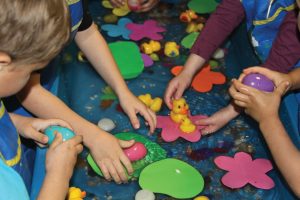 The best education institutions value both STEM programs as well as performance and visual arts. Why? Because there is a synergy to learning any field of study: science helps math which helps music which helps the self which helps the world.
The best education institutions value both STEM programs as well as performance and visual arts. Why? Because there is a synergy to learning any field of study: science helps math which helps music which helps the self which helps the world.
There is value in arts for arts’ sake, but there is more value in arts for developing a complete, well-rounded individual. Self Development Academy and Preschool has been doing this for decades. The educators continue to innovate ways to increase critical and creative thinking, to help foster the next generation of curators of extraordinary works of art and curers of diseases.
A well-rounded and integrated curriculum in a nurturing environment is a must in helping students succeed in elementary school, middle school and beyond. An integrated curriculum with thematic approach in the early years provides a strong foundation in developing lifelong learners.
“I attended Self Development Preschool (SDP) and Self Development Academy (SDA) from the age of two years to the end of eighth grade, and I have fond memories of my teachers and all the friends I made at SDA. Even though the academics were rigorous, it never felt out of the ordinary. Entering high school, I was blown away at how far ahead of the other students we were because of SDA’s advanced curriculum. I found myself taking junior and senior level classes as a freshman. This freed up the time in my schedule later in high school, which meant I could take more classes that I enjoyed along with the normal course load,” says Max Gau, a former student of SDA and now a sophomore at Fordham University in New York.
One of the unfortunate tasks of an educator is compartmentalizing subjects into math, science, visual arts and literature. We create barriers between these subjects as if they exist isolated from each other, that music can exist without the elegance of the math, that visual arts can exist without chemistry, and that literature can exist without the heart.
We can speculate a reason for the separation: it makes the subjects easier to learn. That may be true, but we could also speculate a compromise that does justice to the fact that reality is the composite of these domains unified into a single whole. Ideal early education would recognize this quilt that weaves arts, science, music, and math — it would be an education steeped in the splendor of the Renaissance.
The College Board for the National Coalition for Core Arts (The College Board or Board) opens their review of current research and best practices by stating this truism: arts education bolsters development in other areas.
SDP and SDA have been integrating arts with science and math since it was founded in 1989. The College Board recommends using theatre to help children make sense of the world around them. SDP uses famous plays to understand history and geography and to explore a civilization’s thoughts and aesthetic. The Board remarks that theatre has the benefit of increasing a child’s understanding of themselves in relation to others.
SDA’s new creative writing program asks kindergarteners to rewrite famous plays from the vantage points of different characters to increase empathy and theory of mind (the ability to understand how another child views the same situation).
Scientific literature is replete with evidence that instruction in the arts leads to greater overall academic improvement. Take creativity, it is thought that mathematics is a field of inputs and outputs, of rational thinking, a strict, rigid domain of black and white and precision. But pure mathematics, a profoundly difficult field of mathematics, is based off the dangerous and highly irrational notion: What if the reality isn’t what it seems? What would the math of that world look like? This field is filled with creatives.
Creativity is a natural human skill and it is required in order to be, yes, an artist, but also a breakthrough engineer, a pioneer in cancer therapy, and that doctor that saves lives by thinking outside the box. This is why in the school year 2019-2020, SDA plans to spend additional time teaching critical and creative thinking.
SDA’s creative writing component teaches K-8 students a range of styles. Students at SDA are exposed to poetry, journalism, novel writing, and screenplay writing. Their critical thinking component also starts in kindergarten, exposing all students to logic puzzles and logical thinking.
In middle school, the logic program increases in difficulty. Sixth graders learn informal logic (fallacies and problematic argumentation) and formal logic (propositional and categorical logic). In seventh grade, students learn formal argumentation. In eighth grade, they learn philosophy.
To give your children a strong foundation for developing a love for learning, please contact Self Development Academy, a tuition free, K-8 public charter school, at (480) 641-2640.
You may also give your children an early start by giving them an opportunity to participate in a highly enriched educational environment by contacting Self Development Preschool at (480) 396-3522, a private school that serves students from ages 2 to 5 years, and has a before and after-school program for students up to age 13 years.

